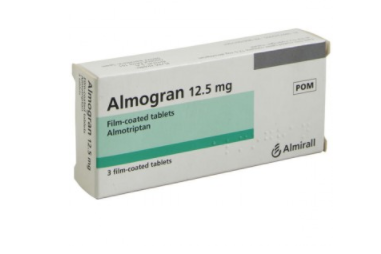Almogran 12.5mg
£18.99 – £35.49
- Fast Acting Migraine Treatment
- Active Ingredient: Almotriptan
- Buy With Confidence From UK Registered Pharmacy
- Includes Free Prescription
Almogran is an antimigraine agent which belongs to a class of compounds known as selective serotonin receptor agonists. Almogran is believed to reduce the inflammatory response associated with migraines by binding to the serotonin receptors in the brain (cranial) blood vessels and causing them to narrow
Click Here To Complete Consultation
Buy more and save!
| Quantity | 1 | 2 | 3 | 4 |
|---|---|---|---|---|
| Price (each) | £18.99 – £35.49 | £17.09 – £31.94 | £16.14 – £30.17 | £15.19 – £28.39 |
| Options | Price | Stock |
|---|---|---|
| 3 Tablets | £18.99 | Out of Stock |
| 6 Tablets | £35.49 | In Stock |

Discreet Packaging

UK Based
-
What Almogran is and what it is used for
Almogran is an antimigraine agent which belongs to a class of compounds known as selective serotonin receptor agonists. Almogran is believed to reduce the inflammatory response associated with migraines by binding to the serotonin receptors in the brain (cranial) blood vessels and causing them to narrow. Almogran is used to relieve headaches associated with migraine attacks with or without aura. See more on Migraines at NHS.UKBefore you take Almogran
Do not take Almogran
- if you are allergic to almotriptan or any of the ingredients of this medicine
- if you have or have ever suffered from diseases that restrict the blood supply to the heart such as:
- heart attack
- chest pain or discomfort that normally occurs with activity or stress
- heart problems without pain
- chest pain that occurs when you are resting
- severe hypertension (severe high blood pressure)
- uncontrolled mild or moderate high blood pressure
- if you have had a stroke or experienced a reduction in the blood flow to the brain
- if you have had obstruction of the large arteries in the arms or legs (peripheral vascular disease)
- if you are taking other medicines used to treat migraines including ergotamine, dihydroergotamine and methysergide or other serotonin agonists (e.g. sumatriptan)
- if you suffer from severe liver disease
How to take Almogran
Almogran should only be used to treat an actual migraine attack and not to prevent migraine attacks or headaches. Always take this medicine exactly as your doctor has told you. Check with your doctor or pharmacist if you are not sure. Adults (18-65 years old) The recommended dose of Almogran is one 12.5 mg tablet which should be taken as early as possible after the onset of the migraine attack. If your migraine attack does not subside, do not take more than one tablet for the same attack. If you experience a second migraine attack within 24 hours, a second 12.5 mg tablet can be taken but you must leave at least two hours between your first and second tablet. The maximum daily dose is two (12.5 mg) tablets within 24 hours. Tablet(s) should be swallowed with liquid (e.g. water) and can be taken with or without food. You should take Almogran as soon as possible after the onset of the migraine, although it is still effective if taken at a later stage.Almogran Ingredients
The active substance in Almogran is almotriptan 12.5 mg (as almotriptan D,L-hydrogen malate). The other ingredients are: Tablet core: Mannitol (E-421), microcrystalline cellulose, povidone, sodium starch glycolate, sodium stearyl fumarate Coating material: Hypromellose, titanium dioxide (E-171), Macrogol 400, carnauba wax See more migraine treatments -
Migraine
A migraine is usually a moderate or severe headache felt as a throbbing pain on one side of the head.
Many people also have symptoms such as nausea, vomiting and increased sensitivity to light or sound.
Migraine is a common health condition, affecting around one in every five women and around one in every 15 men. They usually begin in early adulthood.
There are several types of migraine, including:
migraine with aura – where there are specific warning signs just before the migraine begins, such as seeing flashing lights
migraine without aura – the most common type, where the migraine occurs without the specific warning signs
migraine aura without headache, also known as silent migraine – where an aura or other migraine symptoms are experienced, but a headache doesn’t develop
Some people have migraines frequently, up to several times a week. Other people only have a migraine occasionally. It’s possible for years to pass between migraine attacks.When to seek medical advice
You should see your GP if you have frequent or severe migraine symptoms.Simple painkillers such as paracetamol or ibuprofen can be effective for migraine. However, be careful not to take too many painkillers as this could make it harder to treat headaches over time.
You should also make an appointment to see your GP if you have frequent migraines (on more than five days a month), even if they can be controlled with medication, as you may benefit from preventative treatment.
Causes of migraines
The exact cause of migraines is unknown, although they’re thought to be the result of temporary changes in the chemicals, nerves and blood vessels in the brain.Around half of all people who experience migraines also have a close relative with the condition, suggesting that genes may play a role.
Some people find migraine attacks are associated with certain triggers, which can include:
Emotional triggers:
stress
anxiety
tension
shock
depression
excitementPhysical triggers:
tiredness
poor quality sleep
shift work
poor posture
neck or shoulder tension
jet lag
low blood sugar (hypoglycaemia)
strenuous exercise, if you’re not used to it
starting their periodDietary triggers:
missed, delayed or irregular meals
dehydration
alcohol
the food additive tyramine
caffeine products, such as tea and coffee
specific foods such as chocolate, citrus fruit and cheeseEnvironmental triggers:
bright lights
flickering screens, such as a television or computer screen
smoking (or smoky rooms)
loud noises
changes in climate, such as changes in humidity or very cold temperatures
strong smells
a stuffy atmosphereTreating migraines
There’s no cure for migraines, but a number of treatments are available to help reduce the symptoms.These include:
painkillers – including over-the-counter medicationssuch as paracetamol and ibuprofen
triptans – medications that can help reverse the changes in the brain that may cause migraines
anti-emetics – medications often used to reduce nausea and vomiting
During an attack, many people find that sleeping or lying in a darkened room can also help.Preventing migraines
If you suspect a specific trigger is causing your migraines, such as stress or a certain type of food, avoiding this trigger may help reduce your risk of experiencing migraines.It may also help to maintain a generally healthy lifestyle, including regular exercise, sleep and meals, as well as ensuring you stay well hydrated and limiting your intake of caffeine and alcohol.
If your migraines are severe or you’ve tried avoiding possible triggers and are still experiencing symptoms, your GP may prescribe medication to help prevent further attacks.
Outlook
Migraines can severely affect your quality of life and stop you carrying out your normal daily activities. Some people find they need to stay in bed for days at a time.However, a number of effective treatments are available to reduce the symptoms and prevent further attacks.
Migraine attacks can sometimes get worse over time, but they tend to gradually improve over many years for most people.
-
Side Effects
Like all medicines, this medicine can cause side effects, although not everybody gets them.Common side effects ( may affect up to 1 in 10 people)
dizziness
sleepiness (somnolence)
nausea
vomiting
tirednessUncommon side effects ( may affect up to 1 in 100 people)
sensation of tingling, pricking or numbness of the skin (paraesthesia)
Headache
ringing, roaring or clicking noise in the ears (tinnitus)
heart pounding (palpitations)
tightening of the throat
diarrhoea
discomfort when digesting food (dyspepsia)
dry mouth
muscle pain (myalgia)
bone pain
chest pain
feeling weak (asthenia)Very rare side effects (may affect up to 1 in 10,000 people)
spasm of the heart blood vessels (coronary vasospasm)
heart attack (myocardial infarction)
increased heart rate (tachycardia)
Frequency unknown (frequency cannot be estimated from the available data)
allergic reactions (hypersensitivity reactions), including mouth, throat or hand edema (angioedema)
severe allergic reactions (anaphylactic reactions)
convulsion (seizure)
visual impairment, vision blurred (visual disorders may also occur during a migraine attack itself)
intestinal vasospasm, which may result in intestinal damage (intestinal ischemia). You may
experience abdominal pain and bloody diarrhoea. -
Further Information













